Читать книгу Oral Cells and Tissues - Philias R. Garant - Страница 6
На сайте Литреса книга снята с продажи.
ОглавлениеTable of Contents
Preface
1 Early Tooth Development
Role of the Neural Crest
Development of the Dental Lamina, Enamel Organ, and Dental Papilla
Epithelial-Ectomesenchymal Morphogenetic Regulation of Odontogenesis
Growth and Differentiation Factors That Regulate Tooth Formation
Establishing Coronal Form (Cusp Formation)
Basic Science Correlations
Clinical Correlation: The Human Dentition
2 Dentin
Differentiation of Odontoblasts
Secretion of Dentin Matrix
Structure of Mature Secretory Odontoblasts
Composition of the Dentin Matrix
Mineralization of Mantle and Circumpulpal Dentin
Structure of the Odontoblastic Process and Dentinal Tubules
Formation of Intertubular and Peritubular Dentin
Transport Across the Odontoblastic Layer
Innervation of Dentin and Mechanisms of Pain Sensation
Supply of Blood to the Pulp
Cells and Extracellular Matrix of the Dental Pulp
Basic Science Correlation: The Secretory Pathway
Clinical Correlations
3 Enamel
Differentiation of the Enamel Organ
Structure of Secretion-Stage Ameloblasts
Biology of the Enamel Matrix
Location and Expression of Amelogenin, Ameloblastin, and Tuftelin Genes
Mineralization of the Enamel Matrix
Structure of Transition-Stage Ameloblasts
Formation of the Papillary Layer
Structure of Maturation-Stage Ameloblasts
Structure of Postmaturation-Stage Ameloblasts
Basic Science Correlations
Clinical Correlations
4 Oral Mucosa
Cell Proliferation and Differentiation in Stratified Squamous Epithelia
Structure and Function of the Cornified (Orthokeratinizing) Epithelium: The Epidermal Model
Differentiation of the Oral Mucosa
Basic Science Correlations
Clinical Correlations
5 Gingiva
Epithelial Components of the Gingiva
Expression of Keratins in Gingiva
Expression of Cell Surface Adhesion Molecules in Gingiva
Formation of Dental Cuticles
Organization of Gingival Connective Tissue
Supply of Blood to the Gingiva
Innervation of the Gingiva
Flow and Composition of Gingival Crevicular Fluid
Basic Science Correlations
Clinical Correlations
6 Periodontal Ligament
Development and General Structure of the Periodontal Ligament
Components of the Extracellular Matrix
Supply of Blood to the Periodontal Ligament
Innervation of the Periodontal Ligament
Basic Science Correlations
Clinical Correlations
7 Root Formation and Cementogenesis
Development of the Roots
Cementogenesis in Animal Models
Cementogenesis in Humans
Responsiveness of Cementum
Matrix Proteins, Adhesion Molecules, and Growth Factors of Cementum
Process of Tooth Eruption
Basic Science Correlation: Construction of the Attachment
Clinical Correlation: Cementum Hypoplasia
8 Bone
Types and Functions of Osteogenic Cells
Components of the Bone Matrix
Development and Function of Osteoclasts
Inhibition of Osteoclastic Bone Resorption
Coupling of Bone Formation and Resorption
Influence of Parathyroid Hormone and Calcitonin on Bone Cells
Influence of Growth Factors and Cytokines on Bone Cells
Architecture of the Bone and Replacement of Osteons
Repair of the Bone
Anatomic Characteristics of the Jawbones
Turnover and Remodeling of Alveolar Bone
Basic Science Correlations
Clinical Correlations
9 Salivary Glands
General Composition of a Gland
Development of the Salivary Glands
Basic Structure of Serous and Mucous Cells
Secretion of Saliva
Resynthesis of Proteins
Composition of Saliva
Nonsecretory Components of the Salivary Glands
Structure of the Major Glands
Innervation and Neural Control of Salivary Secretion
Basic Science Correlations
Clinical Correlations
10 Oral Somatosensory Systems
Types of Cutaneous Somatosensory Receptors
Innervation of the Oral Mucosa
Theories of Somatosensory Perception
Innervation and Sensation of the Pulp and Dentin
Nerve Regeneration Following Tooth Extraction
Peptidergic Nerve Endings in Pulp and Gingiva
Basic Science Correlations
Clinical Correlations
11 Muscle
Muscles of Mastication
Muscles of the Tongue, Soft Palate, and Pharynx
Development of Skeletal Muscle
Structure of Skeletal Muscle
Mastication
Structure of Smooth Muscle
Basic Science Correlations
12 Cartilage and Temporomandibular Joint
Development and Structure of Cartilage
Components of the Temporomandibular Joint
Clinical Correlation: Pathoses of the Temporomandibular Joint
13 Immune System
Initiation of Immune Response
Development of T Lymphocytes
Structure of T-Cell Receptors
Structure of Major Histocompatibility Complex Molecules
Processing and Presentation of Antigenic Peptides
Activation of T Cells
Function of Helper T Cells
Function of Cytolytic T Lymphocytes and Classic Natural Killer Cells
Development of B Lymphocytes
Activation of B Cells
Non–Antigen-Specific Activation of T and B Cells
Development of Immunologic Tolerance
Structure and Function of Plasma Cells
Initiation of Serum Antibody Response
Lymphocyte Circulation from Bone Marrow to Secondary Lymphoid and Peripheral Tissues
Role of Keratinocytes in the Immune Response
Role of Dendritic Cells and Langerhans Cells
Basic Science Correlations
Clinical Correlation: Immune Response in Gingival and Periodontal Disease
14 Phagocytic Cells
Development of Polymorphonuclear Neutrophils
Role of Polymorphonuclear Neutrophil Cell Surface Receptors
Activation of Polymorphonuclear Neutrophils
Development and Structure of Monocytes and Macrophages
Types of Monocyte and Macrophage Receptors
Activation of Monocytes
Transmigration of Phagocytic Cells
Chemotaxis
Phagocytosis
Generation of Reactive Oxygen Metabolites
Antimicrobial Agents of Phagocytes
Role of Phagocytes in Regulating Inflammation
Aggregation of Polymorphonuclear Neutrophils
Cytokine Regulation of Phagocytic Cells
Structure and Function of the Complement System
Biologic Effects of Lipopolysaccharide
Glucocorticoid Modulation of the Inflammatory Response
Immunomodulatory Evasion Mechanisms of Microbes
Clinical Correlation: Polymorphonuclear Neutrophil Function and Periodontal Disease
